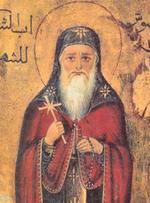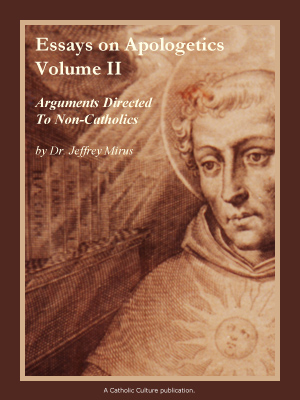Living the Sadness of Christ
By Dr. Jeff Mirus ( bio - articles - email ) | Nov 16, 2016 | In Reviews
The other week, when I was trying to think of something I should write about, I was fresh out of ideas. Even worse, I was feeling bored and lethargic. There can be many different causes for these problems, but in my own case, running out of ideas typically means I am spending too much time fundraising and not enough time reading good things which can stimulate my mind. And feeling bored and lethargic, while it can be perfectly innocent, is too often, for me, a sign of spiritual flabbiness.
In the hope of killing two birds with one stone, I scanned the book shelves where my wife and I store our spiritual reading, in the hope of finding something timeless that she had read but I had not. As I cranked my head over 90 degrees to read the spines of the books, I stumbled upon the works that St. Thomas More wrote when he was facing death in the Tower of London, in 1534 and 1535. More wrote three books during his fifteen-month imprisonment: A Dialogue of Comfort against Tribulation, A Treatise on the Passion, and The Sadness of Christ. It was The Sadness of Christ which seemed most suitable to my own mood.
I am not sure how I missed this the first time around, but perhaps I had simply read it so long ago that I did not remember it very well. After all, I go back a long way, and I have always regarded Thomas More as a personal friend. However, I admit to a tendency to confuse him with Paul Scofield, who played the role of More in the brilliant film, A Man for All Seasons. I was eighteen when that was released in 1966, and it remains my all-time favorite movie.
After I graduated from high school, I went on to major in History in college, and in graduate school I specialized in European intellectual history, with an emphasis on the period from about 1200 to 1700—the high medieval period, the Renaissance, the Protestant Revolt, and the rise of skepticism. Thomas More lived, studied, worked, wrote and died a martyr right in the middle of all this. And I really did consider him a personal friend—something that is quite possible among Catholics. He is, after all, a member of my Church.
Why the Sadness of Christ?
I suppose the answer to why St. Thomas decided to write this book is fairly obvious. He was awaiting the daunting honor of dying for Christ because he refused to acknowledge that King Henry VIII was, or ever could be, the head of Our Lord’s Church in England. He didn’t have much support from other leading Catholics of the day. You’ll recall that only one English bishop, St. John Fisher, was also willing to accept the martyr’s crown. Fisher was executed on June 22, 1535. More followed two weeks later, on July 6th.
Although St. Thomas More was already justly famous as a writer, particularly for his Utopia, the books he wrote while awaiting martyrdom are truly a matter of his loss being our gain. It is hardly surprising that More was extremely sensitive to his own moods as he faced death, with so much time on his hands, and with so little by way of pleasurable distraction. Moreover, few martyrs are radiant with joy throughout their entire trial. Recognizing his own sadness over his fate—and that of his family, not to mention the Church in England—it was only natural the he should find great consolation in the astonishing fact of Our Lord’s own sadness, in the face of His own crucifixion.
I call this sadness “astonishing” only because, at times, we find it difficult to come to grips with Our Lord’s suffering. In the back of our minds lurks the knowledge that He could have gone through His entire passion and death without permitting Himself to feel any distress at all. He could, in other words, have simply gone through the motions to set a good example, obedient to the events ordained by His Father, but with no requirement to permit the distress of His human nature to penetrate His personality.
For Jesus Christ, as a Person, is God. Yes, He took on a human nature, but He is definitely not a human person. As a Divine Person He could have shed His human distress in any way He chose to do so, except for His Father’s will. For the Father did not want Him merely to go through the motions but to feel every last drop of suffering He experienced in His human nature, completely setting aside that glory which He had with the Father before the world was made (Jn 17:5). It is precisely in this that More can find the consolation he so desperately needs.
A brilliant commentary
What St. Thomas does in The Sadness of Christ is to piece together in the proper order all of the gospel texts which cover Our Lord’s passion and death, and then to write a wonderful commentary exploring the depths of His distress. In doing so, St. Thomas must sometimes take up divergent interpretations of the various Scripture passages, giving the reasons for each interpretation, and indicating the interpretation he finds to be most likely.
What, for example, does it mean that Our Lord sweat blood? What did Christ mean when He told His disciples that from now on they would have to carry swords, and then rebuked Peter for using a sword to defend his Master? What is signified by the Gospel’s report that those who came to arrest Him in the Garden of Gethsemane fell to the ground when He identified Himself?
Throughout the 114 pages of commentary, More draws out both the Divine power and the Divine self-emptying of Christ. As More demonstrates with greater and greater certainty the reality of Our Lord’s suffering, the reader’s recognition grows along with the author’s. With increasing power, then, a Divine consolation penetrates the minds and hearts of both. For More, this consolation may be all he had, the one precious reality standing between his desire for strength and his fear of collapse.
For us, of course, the worldly peril is not so powerfully raw. And yet those who love Our Lord cannot escape a large measure of sorrow over the intense sufferings of the Body of Christ in our own time—the trials of His Church. These trials are inflicted from both within and without, and they go on and on and on and on. At times, we can do little but cry out in anguish, speaking not only for ourselves but for the whole Church: “How long, O Lord?”
How long, O LORD? Wilt thou forget me for ever?
How long wilt thou hide thy face from me?
How long must I bear pain in my soul,
and have sorrow in my heart all the day?
How long shall my enemy be exalted over me?
Consider and answer me, O LORD my God;
lighten my eyes, lest I sleep the sleep of death;
lest my enemy say, “I have prevailed over him”;
lest my foes rejoice because I am shaken.
(Psalm 13:1-5)
There is one more verse to the Psalm, which is well worth looking up. But it is only the faithful who feel the Church’s pain, which is to feel Christ’s pain. It is only in the faithful that such pain grows over a lifetime through this wounded and bleeding body which connects us so intimately to Our Lord. Truly, it disturbs those who are unfaithful not at all, though perhaps most of us are mixtures of the two. For Catholics who sorrow, then, both for themselves and for the Church, I can recommend nothing more highly than Thomas More’s The Sadness of Christ.
All comments are moderated. To lighten our editing burden, only current donors are allowed to Sound Off. If you are a current donor, log in to see the comment form; otherwise please support our work, and Sound Off!








